This video by 2 Lt Mathieu Sly discusses the Reconnaissance Operations Commander course, one of the most challenging and rewarding training programs in the Canadian Army.
This video by 2 Lt Mathieu Sly discusses the Reconnaissance Operations Commander course, one of the most challenging and rewarding training programs in the Canadian Army.

LIVE ACTION – Soldiers train with synthetic Claymore mine, mortar, grenade and Stinger weapons systems to determine if they accurately portray a live-fire weapon during an operational demonstration of the STE LTS at the Joint Readiness Training Center, Fort Johnson, Louisiana in January 2024. (Photo by Ariana Aubuchon, PEO STRI)
Haptics improvements to Army simulation training makes virtual environments feel more realistic.
Simulation doesn’t replace live training, but with enhancements to its digital programs, along with haptics improvements, the Army will soon be able to augment existing programs and replicate weapons like direct fire, counter-defilade and directed energy that, until now, couldn’t be replicated through simulation. Making interactions with virtual environments or digital devices feels more realistic and tactile.
Haptics is the use of technology to simulate the sense of touch by applying forces, vibrations or motions to the user via wearable suits or devices (i.e., gloves, vests, watches). While it is not currently used in live force-on-force training—a training method that combines live action with virtual and constructive training—it will be used going forward to bridge the gap between virtual training and real-world experiences. The result is a safer, more effective and more cost-efficient way to prepare Soldiers for various operational scenarios, and this technology is particularly valuable in effectively addressing modern military challenges—from urban warfare to cyber-defense training.
“Haptic technology in combination with immersive VR/AR [virtual reality and augmented reality] technologies and artificial intelligence [AI] form a critical architecture element within emerging Army training systems,” said Chief Technology Officer Marwane Bahbaz, Program Executive Office for Simulation, Training and Instrumentation (PEO STRI). “And simulations using virtual reality and haptic capabilities drastically increase immersion and improve retention and learning in training exercises.” This means that Soldiers can safely and effectively practice high-risk or complex scenarios like piloting a plane or handling dangerous machinery with more confidence and less risk than in real life.
He explained that haptics “increases combat realism in the collective training environment because it induces combat stress to Soldiers, ensuring that the execution of the mission, the decision-making process and the overall combined arms tasks are validated.” Inducing combat stress in the training environment mimics the emotions and fatigue Soldiers could face when engaged in combat so they are better able to anticipate these sensations in the peer threat environment.
The Synthetic Training Environment Live Training System (STE LTS), which uses virtual technology to simulate combat environments for Soldiers, is advancing haptic technology with environmental hardening (increasing resistance to stress or threats) to enhance training resilience and cost efficiency and continues to monitor and invest in evolving haptic innovations.

REAL-WORLD BENEFITS – A Soldier from the 1st Battalion, 509th Infantry Regiment, takes part in an operational demonstration of the Synthetic Training Environment Live Training Systems (STE LTS), designed and fielded by PEO STRI, at the Joint Readiness Training Center at Fort Johnson, Louisiana. STE LTS allows Soldiers to take part in more reps and sets than they would with live fire, while reducing training costs and improving safety. (Photo by Ariana Aubuchon, PEO STRI)
SYNTHETIC TRAINING ENVIRONMENT
In 2017, the Army began developing the Synthetic Training Environment (STE) with the goal of achieving initial operational capability by 2021 and full operational capability (a highly realistic and immersive training environment) by 2023. Some features are currently being used for training, while the full system is still under development and deployment.
The STE integrates virtual reality and augmented reality to create immersive, realistic training scenarios across multiple domains—land, sea, air, space and cyber. By enhancing training with VR and AR, Soldiers can experience complex, large-scale environments and situations that are difficult or impossible to replicate in live training, improving readiness, decision-making and coordination in a cost-effective manner.
“The vision of the Army’s Synthetic Training Environment is to revolutionize Army training by merging live, virtual, constructive [LVC] and gaming platforms into an interoperable training experience that provides real-life immersion for combat training,” said Bahbaz. The blending of these domains enables decentralized training, reduces wear on tactical equipment and provides additional tools to enhance training effectiveness. This provides significant value for brigade and company-level training, benefiting forward observers (fire support specialists, artillery observers) and mortarmen crews.
PEO STRI’s Project Manager Training Devices (PM TRADE) has developed instrumented mortars capable of engaging targets across the LVC spectrum, Bahbaz explained, including live instrumented Soldiers, the virtual Training Simulation Software (TSS) Soldier and constructive simulation-generated entities. Using an immersive VR headset, the forward observer can visualize the entire battlefield in real-time, seeing LVC entities in their exact locations. The device provides a fully virtualized view of the battlefield, using high-resolution, three-dimensional terrain models that are updated in real time—allowing the forward observer to pan and zoom the digital battlefield, provide targeting information and call in indirect fire on targets across the LVC spectrum. This capability, he said, allows for a highly realistic and dynamic training environment and can be used to supplement training when live personnel or vehicle platforms are unavailable.
These haptic technologies are currently in the prototyping phase, where the performance and effectiveness is evaluated in a live training environment through the use of Soldier touch points conducted throughout a wide range of locations, including Fort Cavazos, Fort Benning, Fort Irwin, Fort Bragg, Fort Wainwright and Fort Polk. Bahbaz noted that, as a result of the PEO STRI touch points, PM TRADE received both positive and constructive feedback from Soldiers, which was critical in informing requirements and design improvements.
Bahbaz anticipates that these capabilities will be procured in fiscal year 2025 and fielded, starting in fiscal year 2026, to the Combat Training Center sites. This will begin with the Joint Readiness Training Center at Fort Johnson, Louisiana, then the National Training Center at Fort Irwin, California, followed by the Joint Multination Readiness Center in Hohenfels, Germany.
PM TRADE will start fielding with the indirect fire mortar and artillery training systems, he said, followed by shoulder-launched munitions and others, mainly because they enhance realism by providing tactile feedback for recoil, loading and firing, which helps develop muscle memory and operational skills.

STING OPERATION – The Stinger training system, which is being developed by Program Executive Office for Simulation, Training and Instrumentation (PEO STRI) as part of the STE-Live Direct Fires program, provides realistic and immersive training for Soldiers. (Photo by Ariana Aubuchon, PEO STRI)
LIVE TRAINING
For the next generation of dismounted Tactical Engagement Simulation Systems (TESS)— designed for infantry or ground-based personnel to simulate real-world combat scenarios without live ammunition—PEO STRI is prototyping haptic alerts to the Soldiers for firing, near miss, wound assessments and suppression.
“The current Live Tactical Engagement Simulation Systems use audio alters for near miss and assessment, which also provides an alert to nearby opposing Soldiers,” said Mark Dasher, product lead for STE LTS. “Use of haptics will provide a silent alert when battlefield effects occur. Additionally, tactical haptics will introduce new training capabilities such as loading ‘training round’ into a 155 mm howitzer.”
During live force-on-force training, the integration of artificial intelligence and machine learning (AI/ML) is going to be a key focus area for live prototyping efforts at many levels, Dasher said. For this training, real Soldiers, using real equipment in physical environments, engage in simulated combat against other live participants—with the addition of synthetic computer-generated elements to enhance realism and complexity. “First, we are applying AI/ML in engagements allowing proper combat techniques [e.g., target lead and site elevation],” Dasher said. This will provide real-time, data-driven feedback, as AI creates moving targets and realistic conditions, while ML adapts training to individual skill levels, analyzing performance to refine accuracy and decision-making. “We believe that AI/ML will provide a continuous evaluation of Soldier and unit actions, enabling better unit training strategies. In the future, AI/ML will support small-unit training without the need of trainers, exercise control, OPFOR [Opposing Forces] or external enablers.”
Live training systems are utilized not just by the Army but also by other services, particularly the U.S. Marine Corps (USMC). “We work closely with PM TRASYS [Program Manager for Training Systems], our USMC counterparts in modernization efforts,” Bahbaz said. “They participate in our Soldier touch points and provide valuable feedback to our team.”
Bahbaz said PEO STRI has also forged a solid partnership with the Program Executive Office for Intelligence, Electronic Warfare and Sensors Project Linchpin, the Army’s first artificial intelligence pipeline to deliver AI and ML capabilities to sensors for faster and more accurate decision-making in collaboration with the STE cross-functional team.
“We have successfully released, jointly, a request for information that communicates AI needs for Army training. This is part of our STRI to efficiently accelerate AI adoption across the training portfolio and specifically in [the] STE program, starting with live.” Bahbaz said he received 82 responses spanning traditional (defense-focused industries) and non-traditional (commercial business with advanced commercial technologies, particularly in the digital space) with diverse experience, which will expand—even transform—the Defense Industrial Base. “This market research effort will shape the prototyping requirements of our modernization programs with respect to AI and data,” he said.
PEO STRI, Bahbaz said, is also investing in computer vision technology as a potential replacement for lasers currently used by the Instrumentable Multiple Integrated Laser Engagement System (I-MILES), a system that enables the Army to simulate combat and improve the realism of training.
“Object detection will enable us to simulate physics-based direct fire engagement, further increasing the realism in the live training environment,” Bahbaz said, adding that recent engineering touch points have yielded promising results as haptic devices attempt to draw reaction of the forces as they maneuver in the force-on-force battle space.
At Soldier Touch Point 10 (a testing session point of refinement), he explained that two haptic devices were tested: 1) a haptic watch that also provided an electronic MILES casualty card to process and display battle damage assessment on their training system in fidelity that allows the performance of exercise medical tasks in a combat training exercise; and 2), a haptic Small Arms Protective Insert replacement, a type of body armor that provides a tactile feedback sensation when impacted by a bullet, allowing the wearer to perceive a hit without feeling the full force.
Bahbaz said PEO STRI is experimenting with these haptic wearables to introduce the effects of explosions that are also integrated with mixed-reality devices and to increase the fidelity of interactions between live participants and synthetic entities in live exercises.
A “STAGES IN STAGES” APPROACH
Bahbaz said there are two live training modern products that will include a “stages in stages” approach, meaning phased in as technology matures and is validated. These two products are the Indirect Fire and Guide System (i.e., Stinger Trainer), with the first increment production planned to begin in fiscal year 2025 and fielding in fiscal year 2027, and the Direct Fire System with haptic and AI-enabled system, which is currently in the prototyping stage and scheduled for production in fiscal year 2027 and fielding in fiscal year 2028-29.
The Stinger Training System provides realistic and immersive training for military personnel, enabling them to effectively operate and maintain the Stinger missile system in a variety of combat scenarios and to simulate the complexities of real-world engagements. This allows users to develop the skills and confidence needed to accurately detect, track and engage enemy aircraft, while minimizing the risks and costs associated with live-fire training.
The system requires the gunner to perform all tasks involved in Stinger operation and target engagement. The life-sized Stinger trainer connects to range instrumentation, delivering realistic training without firing projectiles and can interrogate instrumented aircraft utilizing a simulated Identification Friend or Foe (IFF), replicating the dimensions, weight and firing sequence of a real Stinger weapon system.
A direct fire system with haptic and AI-enabled capabilities is a training platform designed to simulate a realistic use of the weapon in the force-on-force environment. According to Bahbaz, these systems leverage haptics to provide physical feedback, such as recoil, vibrations and resistance, replicating the sensations of real-world weapon handling. At the same time, AI introduces adaptive elements to the training or operational environment, like intelligent target behaviors, real-time performance analysis and scenario adjustments.
For example, a rifle or machine gun training simulator equipped with haptics will simulate the weapons recoil and resistance while engaging AI-controlled targets that react unpredictably to the Soldier’s kinetic actions and reinforce rapid decision-making. The system, Bahbaz said, will provide feedback on accuracy, reaction time and situational awareness, adapting the scenarios’ difficulty as the training environment changes.
These systems utilize AI to simulate lively scenarios like engaging aerial or ground threats, adapting to trainee performance and providing detailed feedback on decision-making and accuracy. Haptics enhancements also add a layer of physical realism by replicating sensations like weapon recoil, weight and control resistance, helping users develop muscle memory and familiarity with equipment. Together, these technologies ensure comprehensive preparation by addressing both the cognitive and physical aspects of weapon operation in a safe, controlled environment.

HALF PAST HAPTICS – A wrist-worn device like this watch can be worn by Soldiers to provide situational awareness, biometric data, and a real-time casualty assessment during training. These improvements in haptics will help to provide a more realistic training environment and bridge the gap between virtual training and real-world experiences. (U.S. Army photo, courtesy of PEO STRI)
GOING GLOBAL
U.S. simulation training is conducted globally to enhance interoperability with allied forces, improve mission readiness and adapt to region-specific challenges. These exercises allow multinational forces to train together using advanced technologies, fostering seamless collaboration in joint operations. Simulation training is also cost effective and safer compared to live exercises, enabling realistic practice without the logistical complexities or risks. By deploying this training worldwide, the U.S. not only prepares for diverse operational scenarios but also demonstrates leadership in cutting-edge military technology.
“PM TRADE provides training capability for home station, Combat Training Centers and for use during deployments. Where the Army is, the Army trains. As haptic-enabled TESS is deployed, the Army will use globally as needed,” Dasher said.
“These improvements can be used by our multination partners,” Bahbaz noted. “In fact, we collaborate closely with our Five Eyes [Oversight and Review Council composed of intelligence oversight, review and security entities of Australia, Canada, New Zealand, the United Kingdom and the United States] on several live training technologies. They are well informed of the core design of training capabilities and have various engagements [where] we exchange our lessons learned to ensure interoperability.”
CONCLUSION
Improving haptics within the STE offers significant benefits for enhancing the Army’s training capabilities. These advancements create a more immersive and realistic training experience by bridging the gap between virtual scenarios and visual sensations. Wearables enable real-time biometric feedback, which can improve training effectiveness by monitoring Soldier performance, stress levels and physical conditions. Enhanced haptics deliver tactile and force feedback, allowing Soldiers to experience the sensations of weapon recoil, environmental resistance and physical impacts while fostering muscle memory and situational awareness. By integrating these technologies, the STE not only better replicates real-world conditions but also reduces the logistical burden and cost of live training exercises. This comprehensive approach ensures that Soldiers are better prepared for operational challenges, leading to improved readiness, adaptability and mission success.
“A critical resource is time for units to train, especially at the lower level (e.g., squad or platoon). Through the insertion of new technology, STE LTS is creating training devices that are both easy to use and realistic,” Dasher said. “The benefit of these enhancements and new additions is allowing units to do realistic training, anywhere and at any time.”
For more information, go to www.peostri.army.mil
By Cheryl Marino for Army AL&T Magazine
CHERYL MARINO provides contract support to the U.S. Army Acquisition Support Center at Fort Belvoir, Virginia, as a writer and editor for Army AL&T magazine and TMGL, LLC. Prior to USAASC, she served as a technical report editor at the Combat Capabilities Development Command Center at Picatinny Arsenal for five years. She holds a B.A. in communications from Seton Hall University and has more than 25 years of writing and editing experience in both the government and private sectors.
GREAT NECK, N.Y. – June 16, 2025 – Laser Ammo USA Inc. is excited to announce the launch of its Recoil Enabled H&K USP training pistols, offered in both Compact and Full-Size .45 models. These innovative training pistols, officially licensed Heckler & Koch USP from Umarex, are outfitted with Laser Ammo’s REAL (Recoil Enabled Airsoft Laser) Conversion Barrel and feature a PST (piston) cap in Red or Infrared laser. Designed to provide a realistic and effective training experience, these training pistols deliver authentic recoil, trigger response and point-of-aim feedback. The Recoil Enabled H&K USP training pistols, based on the Compact H&K Platform and H&K USP Full-Size .45, are now available for purchase.

“The H&K USP is widely trusted and used by law enforcement and military professionals in Europe, and now Laser Ammo is proud to introduce these training pistols to the U.S. market, as well as to our clients who demand realistic, high-quality training tools,” said Matan Keller, Laser Ammo’s European Managing Director. “Our team set out to deliver a training solution that replicates the feel and performance of the real firearm. We’re proud to offer a system that not only supports effective skill development but also enhances safety and readiness.”
The Recoil Enabled H&K USP Compact is ideal for concealed carry training and small-handed shooters, offering exceptional training for holster draw, trigger control and target transition drills. The compact model features an ambidextrous magazine release, an extended trigger guard and white 3-dot combat sights. Additionally, it includes functional slide lock, magazine release and takedown features for a comprehensive training experience.
For shooters seeking duty weapon simulation, the Recoil Enabled H&K USP Full-Size .45 is designed to accurately replicate the weight and feel of the pistol that inspires it. The Full-Size model is excellent for holster draw practice, trigger control, reload drills and tactical movement. It includes a functional slide, safety, magazine release and takedown lever, all built on a durable polymer frame with a metallic alloy slide. Engineered for long-term use and high-volume dry fire sessions, this training pistol ensures that shooters can train with confidence without wear and tear.
With the launch of the Recoil Enabled H&K USP training pistols, Laser Ammo continues to lead the way in providing advanced training solutions for law enforcement, military and civilian markets. By adding spare magazines or pairing with Laser Ammo’s interactive multi training target system (i-MTTS) and/or the Smokeless Range® shooting simulator, serious shooters can further elevate the H&K’s training experience. The Recoil Enabled H&K USP Compact is available to purchase here for an MSRP starting at $425.00. The Recoil Enabled H&K USP Full-Size .45 is available to purchase here for an MSRP starting at $425.00
For more information on Laser Ammo, visit LaserAmmo.com or find Laser Ammo on Instagram, Facebook, LinkedIn, Twitter/X or YouTube.
The Army has just published a “major revision” to the draft version of AR 350-1 Army Training and Leader Development, which has been floating around in draft format for the past few months.
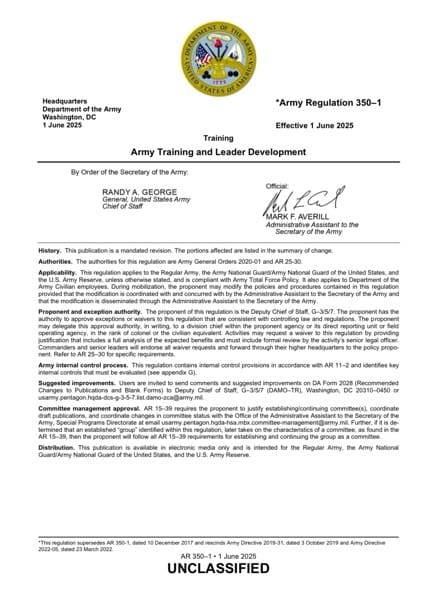
The new directive is half of the size it used to be!
This major revision, dated 1 June 2025—
• Removes “resilience” (common mandatory training) (table C–1).
• Incorporates guidance from Executive Order 14183 (throughout).
• Incorporates guidance from Army Directive 2018-02, Global Cultural Knowledge Network, 4 April 2018 (throughout).
• Incorporates guidance from Army Directive 2018-07-4, Prioritizing Efforts-Readiness and Lethality (Update 4), dated 26 April 2018 (throughout).
• Incorporates guidance from Army Directive 2018-07-05, Prioritizing Efforts-Readiness and Lethality (Update 5), dated 9 May 2018 (throughout).
• Incorporates guidance from Army Directive 2018-07-11, Prioritizing Efforts-Readiness and Lethality (Update 11), dated 26 June 2018 (throughout).
• Incorporates guidance from Army Directive 2018-07-17, Prioritizing Efforts-Readiness and Lethality (Update 17), dated 28 November 2018 (throughout).
• Incorporates guidance from Army Directive 2018-07-18, Prioritizing Efforts-Readiness and Lethality (Update 18), dated 4 January 2019 (throughout).
• Incorporates guidance from Army Directive 2018-22, Retention Policy for Non-deployable Soldiers, dated 8 November 2022 (throughout).
• Incorporates and rescinds guidance from Army Directive 2019-31, Integration or Refresher Training for Prior Service Personnel, dated 3 October 2019 (throughout).
• Incorporates guidance from Army Directive 2021-08, Implementation and Sustainment of Army Medical Department Individual Critical Task Lists, dated 19 March 2021 (throughout).
• Incorporates guidance from Army Directive 2021-17, Lateral Appointment to Corporal and Eligibility for Basic Leaders Course, dated 21 May 2021 (throughout).
• Incorporates and rescinds guidance from Army Directive 2022-05, Army Combat Fitness Test, dated 23 March 2022 (throughout).
• Incorporates guidance from Army Directive 2023-11, Army Body Fat Assessment for the Army Body Composition, dated 9 June 2023 (throughout).
• Incorporates guidance from Army Directive 2025-02, Parenthood, Pregnancy, and Postpartum, dated 24 February 2025 (throughout).
• Incorporates guidance from Army Directive 2025-04, Initial Entry Training for Reserve Component Soldiers, dated 25 March 2025 (throughout).
• Incorporates guidance from Army Directive 2025-06, Army Fitness Test, dated 17 April 2025 (throughout).
• Changes Army Combat Fitness Test to Army Fitness Test (throughout).
• Removes requirements for Home Station Master Plan, Army Training Strategy, and Army Leader Development Strategy (throughout).
• Deletes previous chapters on Culture and Language and Distributed Learning Program (throughout).
• Reduces Training Support System content in this regulation; rather referring to specific regulations (throughout).
I realize it won’t make everyone happy but it eliminates some extraneous mandatory training requirements and allows commanders flexibility to concentrate on more mission focused training.
Get your copy here.
During last week’s Operator Expo I spoke with Sparrow Lock Picks and I learned about the upcoming Rock’a Lock’a Bang! Bang! II. What I heard was simply amazing. I don’t think there has ever been another training opportunity quite like this one. I’d go further than calling this training. This is a once-in-a-lifetime experience.

The event takes place in a prison. If you choose to take this mission, your three day prison sentence is in Carson City, Nevada, SEPTEMBER 11-14, 2025.
Subject matter experts will lead this group of prisoners through a wide range of learning.
All of these skills will then be put to use on the final day as participants are placed into Tiger teams and assigned multiple tasks in seemingly real world environments.
You’ll stay in Reno and all meals and transportation to and from the prison in Carson City each day will be provided.
Here’s a video from last year’s inaugural event.
To learn more, visit www.sparrowslockpicks.com/products/rocka-locka-bang-bang-ii.
JACQUEVILLE, CôTE D’IVOIRE
Flintlock 2025, U.S. Africa Command’s annual, combined special operations exercise, kicked off in Côte d’Ivoire today. From April 24 – May 14, Flintlock 25 will bring together approximately 500 personnel from more than 30 nations to strengthen collective readiness in response to shared threats.
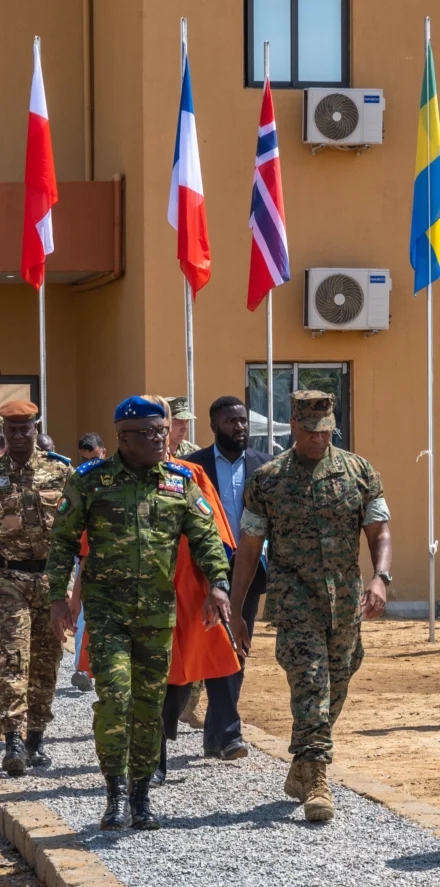
“Twenty years of Flintlock and our resolve is stronger than ever. Together, with our partners and allies, we are forging lethal forces ready to deter aggression and win on the battlefield,” said U.S. Marine Corps Gen. Michael Langley, Commander of U.S. Africa Command. “U.S. Africa Command is committed to countering threats to the United States and working alongside our African partners as they play a leading role in providing for their own defense.”
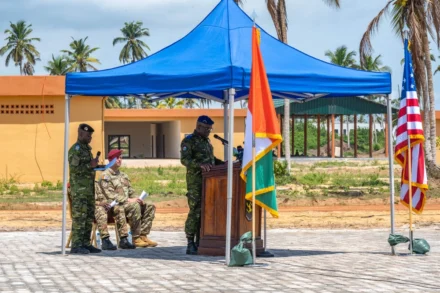
This iteration, hosted by Côte d’Ivoire, reflects the dedication by African partners to address regional challenges independently while still working with international partners for global peace. The exercise will consist of academics, then shift to a staff and command post exercise.

Exercise scenarios are designed to strengthen partner nations’ collective abilities to counter violent extremist organizations, collaborate across borders, provide security, respect human rights and build trust with civilian populations. The exercise also bolsters information sharing between African, U.S., and other partner nation military and law enforcement organizations through an interagency fusion cell.
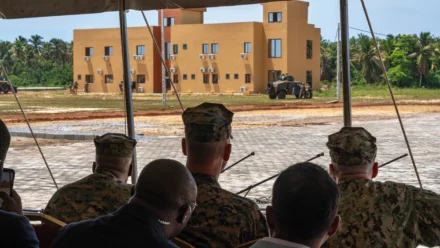
“Flintlock demonstrates our long-term commitment to improve partner-nation operational independence,” said U.S. Army Maj. Patrick Temperato, Flintlock lead planner. “Integrated operations planned on a foundation of shared values and interests are critical to reinforcing an extended network of like-minded nations capable of decisively meeting the defense challenges of today and tomorrow.”
For more information, visit www.africom.mil/what-we-do/exercises/flintlock.
Story by Staff Sgt. Zachary Wright
Special Operations Command Africa
From Australia comes Boresight and their family of target drones. Designed to be used as an aerial target, the BQ400 quadcopter is a low-cost drone. It has a flight duration of 25 minutes and can fly over 2500m at speed of up to 17.5 m/s.
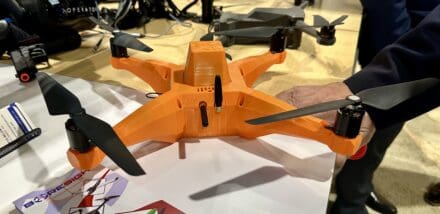
Using the ground control system, routes are preprogrammed and fly consistently sortie after sortie for live fire gunnery (both kinetic and non-kinetic) training. The one to many control allows one operator to fly up to 10 drones on the same route to mimic swarm scenarios.

Boresight also has a US footprint in Huntsville, Alabama. They are introducing new target drones including a larger quadcopter and Class 1 fixed wing model.
Achilles Heel Tactical, founded by Rick Crawley, is proud to announce the launch of Field Notes, a new section of the AHT website dedicated to delivering hard-earned knowledge, straight from the front lines of the firearms training industry.
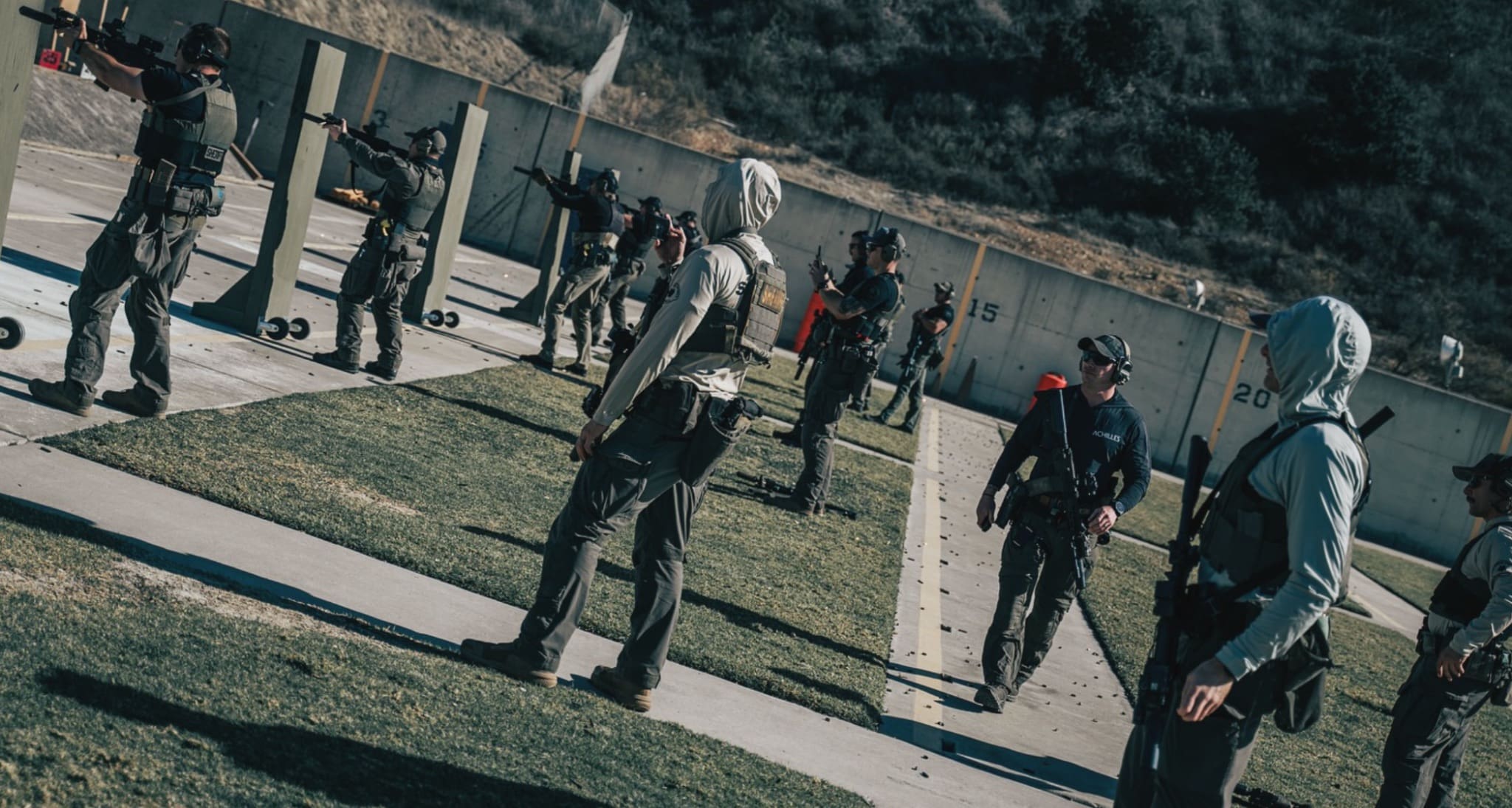
This isn’t your average blog. Field Notes is a raw, insightful, and skill-driven content hub created for shooters who take their craft seriously—whether you’re a law enforcement professional, an armed civilian, or a responsibly armed American who refuses to be a victim.
Drawing from his experience as a Marine Corps Infantry veteran, law enforcement officer, and founder of one of the most respected training companies in the industry, Rick Crawley breaks down skills, tactics, and gear in a way that actually makes you better.
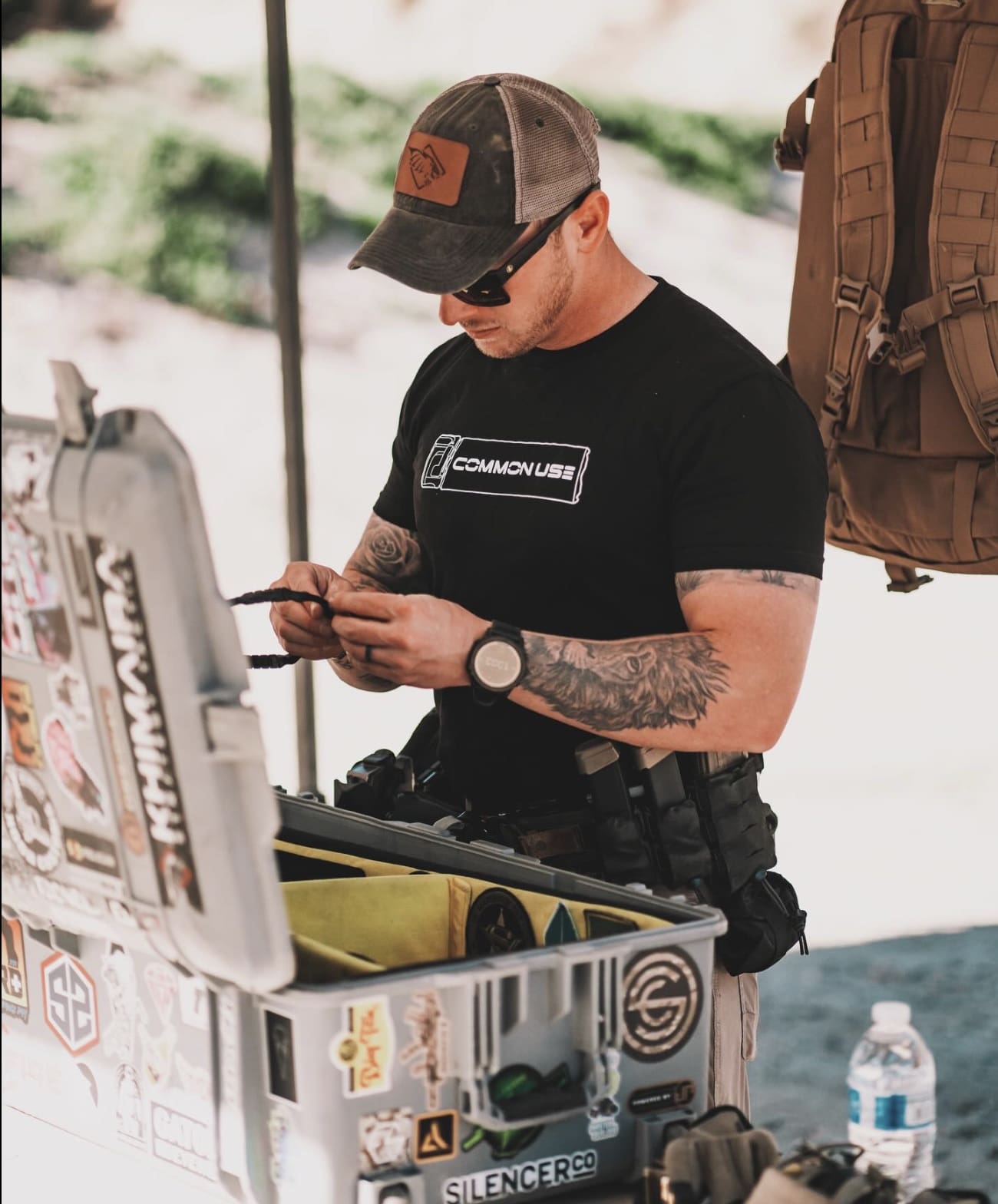
“The mission is simple: give people the tools and mindset to be more lethal, more capable, and more prepared,” says Crawley. “Firearms training isn’t just about punching holes in paper—it’s about decision-making, discipline, and being dangerous for the right reasons.”
Field Notes covers everything from:
– Proven shooting drills that build real-world performance
– Deep dives on red dot optics, rifle setups, and EDC gear
– Tactics that translate from the range to the street
– Mental frameworks that separate good shooters from great ones
Every post is designed to cut through the fluff and deliver actionable insights that shooters can immediately apply.
If you carry a gun for a living—or carry one to protect what matters—this is for you.
Start reading now at: www.achillesheeltactical.com/field-notes
Stay sharp. Stay dangerous. And stay ahead of the threat.